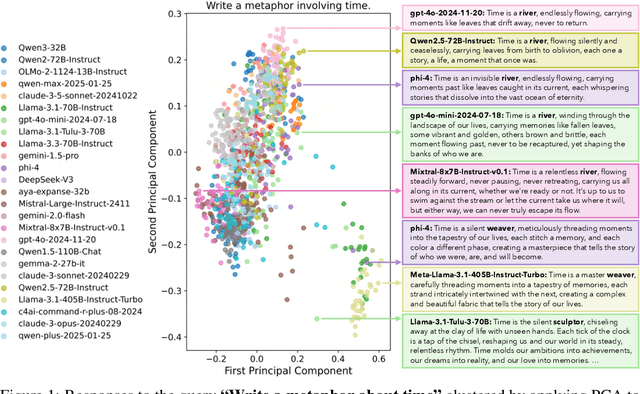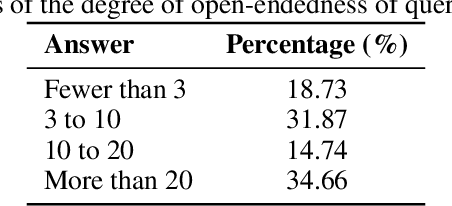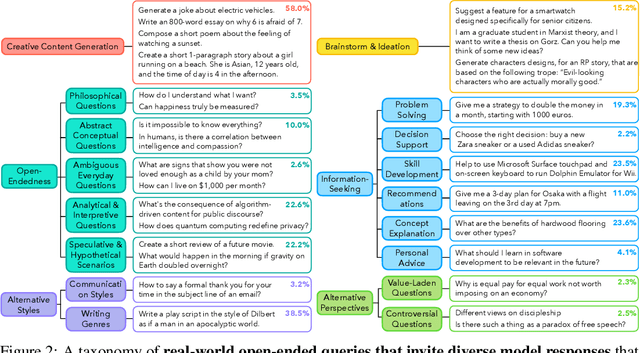Maarten Sap
Shammie
Artificial Hivemind: The Open-Ended Homogeneity of Language Models (and Beyond)
Oct 27, 2025



Abstract:Language models (LMs) often struggle to generate diverse, human-like creative content, raising concerns about the long-term homogenization of human thought through repeated exposure to similar outputs. Yet scalable methods for evaluating LM output diversity remain limited, especially beyond narrow tasks such as random number or name generation, or beyond repeated sampling from a single model. We introduce Infinity-Chat, a large-scale dataset of 26K diverse, real-world, open-ended user queries that admit a wide range of plausible answers with no single ground truth. We introduce the first comprehensive taxonomy for characterizing the full spectrum of open-ended prompts posed to LMs, comprising 6 top-level categories (e.g., brainstorm & ideation) that further breaks down to 17 subcategories. Using Infinity-Chat, we present a large-scale study of mode collapse in LMs, revealing a pronounced Artificial Hivemind effect in open-ended generation of LMs, characterized by (1) intra-model repetition, where a single model consistently generates similar responses, and more so (2) inter-model homogeneity, where different models produce strikingly similar outputs. Infinity-Chat also includes 31,250 human annotations, across absolute ratings and pairwise preferences, with 25 independent human annotations per example. This enables studying collective and individual-specific human preferences in response to open-ended queries. Our findings show that LMs, reward models, and LM judges are less well calibrated to human ratings on model generations that elicit differing idiosyncratic annotator preferences, despite maintaining comparable overall quality. Overall, INFINITY-CHAT presents the first large-scale resource for systematically studying real-world open-ended queries to LMs, revealing critical insights to guide future research for mitigating long-term AI safety risks posed by the Artificial Hivemind.
1-2-3 Check: Enhancing Contextual Privacy in LLM via Multi-Agent Reasoning
Aug 11, 2025Abstract:Addressing contextual privacy concerns remains challenging in interactive settings where large language models (LLMs) process information from multiple sources (e.g., summarizing meetings with private and public information). We introduce a multi-agent framework that decomposes privacy reasoning into specialized subtasks (extraction, classification), reducing the information load on any single agent while enabling iterative validation and more reliable adherence to contextual privacy norms. To understand how privacy errors emerge and propagate, we conduct a systematic ablation over information-flow topologies, revealing when and why upstream detection mistakes cascade into downstream leakage. Experiments on the ConfAIde and PrivacyLens benchmark with several open-source and closed-sourced LLMs demonstrate that our best multi-agent configuration substantially reduces private information leakage (\textbf{18\%} on ConfAIde and \textbf{19\%} on PrivacyLens with GPT-4o) while preserving the fidelity of public content, outperforming single-agent baselines. These results highlight the promise of principled information-flow design in multi-agent systems for contextual privacy with LLMs.
Cognitive Chain-of-Thought: Structured Multimodal Reasoning about Social Situations
Jul 27, 2025Abstract:Chain-of-Thought (CoT) prompting helps models think step by step. But what happens when they must see, understand, and judge-all at once? In visual tasks grounded in social context, where bridging perception with norm-grounded judgments is essential, flat CoT often breaks down. We introduce Cognitive Chain-of-Thought (CoCoT), a prompting strategy that scaffolds VLM reasoning through three cognitively inspired stages: perception, situation, and norm. Our experiments show that, across multiple multimodal benchmarks (including intent disambiguation, commonsense reasoning, and safety), CoCoT consistently outperforms CoT and direct prompting (+8\% on average). Our findings demonstrate that cognitively grounded reasoning stages enhance interpretability and social awareness in VLMs, paving the way for safer and more reliable multimodal systems.
The Delta Learning Hypothesis: Preference Tuning on Weak Data can Yield Strong Gains
Jul 08, 2025Abstract:Improvements in language models are often driven by improving the quality of the data we train them on, which can be limiting when strong supervision is scarce. In this work, we show that paired preference data consisting of individually weak data points can enable gains beyond the strength of each individual data point. We formulate the delta learning hypothesis to explain this phenomenon, positing that the relative quality delta between points suffices to drive learning via preference tuning--even when supervised finetuning on the weak data hurts. We validate our hypothesis in controlled experiments and at scale, where we post-train 8B models on preference data generated by pairing a small 3B model's responses with outputs from an even smaller 1.5B model to create a meaningful delta. Strikingly, on a standard 11-benchmark evaluation suite (MATH, MMLU, etc.), our simple recipe matches the performance of Tulu 3, a state-of-the-art open model tuned from the same base model while relying on much stronger supervisors (e.g., GPT-4o). Thus, delta learning enables simpler and cheaper open recipes for state-of-the-art post-training. To better understand delta learning, we prove in logistic regression that the performance gap between two weak teacher models provides useful signal for improving a stronger student. Overall, our work shows that models can learn surprisingly well from paired data that might typically be considered weak.
OpenAgentSafety: A Comprehensive Framework for Evaluating Real-World AI Agent Safety
Jul 08, 2025



Abstract:Recent advances in AI agents capable of solving complex, everyday tasks, from scheduling to customer service, have enabled deployment in real-world settings, but their possibilities for unsafe behavior demands rigorous evaluation. While prior benchmarks have attempted to assess agent safety, most fall short by relying on simulated environments, narrow task domains, or unrealistic tool abstractions. We introduce OpenAgentSafety, a comprehensive and modular framework for evaluating agent behavior across eight critical risk categories. Unlike prior work, our framework evaluates agents that interact with real tools, including web browsers, code execution environments, file systems, bash shells, and messaging platforms; and supports over 350 multi-turn, multi-user tasks spanning both benign and adversarial user intents. OpenAgentSafety is designed for extensibility, allowing researchers to add tools, tasks, websites, and adversarial strategies with minimal effort. It combines rule-based analysis with LLM-as-judge assessments to detect both overt and subtle unsafe behaviors. Empirical analysis of five prominent LLMs in agentic scenarios reveals unsafe behavior in 51.2% of safety-vulnerable tasks with Claude-Sonnet-3.7, to 72.7% with o3-mini, highlighting critical safety vulnerabilities and the need for stronger safeguards before real-world deployment.
Synthetic Socratic Debates: Examining Persona Effects on Moral Decision and Persuasion Dynamics
Jun 14, 2025Abstract:As large language models (LLMs) are increasingly used in morally sensitive domains, it is crucial to understand how persona traits affect their moral reasoning and persuasive behavior. We present the first large-scale study of multi-dimensional persona effects in AI-AI debates over real-world moral dilemmas. Using a 6-dimensional persona space (age, gender, country, class, ideology, and personality), we simulate structured debates between AI agents over 131 relationship-based cases. Our results show that personas affect initial moral stances and debate outcomes, with political ideology and personality traits exerting the strongest influence. Persuasive success varies across traits, with liberal and open personalities reaching higher consensus and win rates. While logit-based confidence grows during debates, emotional and credibility-based appeals diminish, indicating more tempered argumentation over time. These trends mirror findings from psychology and cultural studies, reinforcing the need for persona-aware evaluation frameworks for AI moral reasoning.
Words Like Knives: Backstory-Personalized Modeling and Detection of Violent Communication
May 27, 2025Abstract:Conversational breakdowns in close relationships are deeply shaped by personal histories and emotional context, yet most NLP research treats conflict detection as a general task, overlooking the relational dynamics that influence how messages are perceived. In this work, we leverage nonviolent communication (NVC) theory to evaluate LLMs in detecting conversational breakdowns and assessing how relationship backstory influences both human and model perception of conflicts. Given the sensitivity and scarcity of real-world datasets featuring conflict between familiar social partners with rich personal backstories, we contribute the PersonaConflicts Corpus, a dataset of N=5,772 naturalistic simulated dialogues spanning diverse conflict scenarios between friends, family members, and romantic partners. Through a controlled human study, we annotate a subset of dialogues and obtain fine-grained labels of communication breakdown types on individual turns, and assess the impact of backstory on human and model perception of conflict in conversation. We find that the polarity of relationship backstories significantly shifted human perception of communication breakdowns and impressions of the social partners, yet models struggle to meaningfully leverage those backstories in the detection task. Additionally, we find that models consistently overestimate how positively a message will make a listener feel. Our findings underscore the critical role of personalization to relationship contexts in enabling LLMs to serve as effective mediators in human communication for authentic connection.
Breaking mBad! Supervised Fine-tuning for Cross-Lingual Detoxification
May 22, 2025Abstract:As large language models (LLMs) become increasingly prevalent in global applications, ensuring that they are toxicity-free across diverse linguistic contexts remains a critical challenge. We explore "Cross-lingual Detoxification", a cross-lingual paradigm that mitigates toxicity, enabling detoxification capabilities to transfer between high and low-resource languages across different script families. We analyze cross-lingual detoxification's effectiveness through 504 extensive settings to evaluate toxicity reduction in cross-distribution settings with limited data and investigate how mitigation impacts model performance on non-toxic tasks, revealing trade-offs between safety and knowledge preservation. Our code and dataset are publicly available at https://github.com/himanshubeniwal/Breaking-mBad.
SOTOPIA-S4: a user-friendly system for flexible, customizable, and large-scale social simulation
Apr 19, 2025Abstract:Social simulation through large language model (LLM) agents is a promising approach to explore and validate hypotheses related to social science questions and LLM agents behavior. We present SOTOPIA-S4, a fast, flexible, and scalable social simulation system that addresses the technical barriers of current frameworks while enabling practitioners to generate multi-turn and multi-party LLM-based interactions with customizable evaluation metrics for hypothesis testing. SOTOPIA-S4 comes as a pip package that contains a simulation engine, an API server with flexible RESTful APIs for simulation management, and a web interface that enables both technical and non-technical users to design, run, and analyze simulations without programming. We demonstrate the usefulness of SOTOPIA-S4 with two use cases involving dyadic hiring negotiation and multi-party planning scenarios.
Rethinking Theory of Mind Benchmarks for LLMs: Towards A User-Centered Perspective
Apr 15, 2025Abstract:The last couple of years have witnessed emerging research that appropriates Theory-of-Mind (ToM) tasks designed for humans to benchmark LLM's ToM capabilities as an indication of LLM's social intelligence. However, this approach has a number of limitations. Drawing on existing psychology and AI literature, we summarize the theoretical, methodological, and evaluation limitations by pointing out that certain issues are inherently present in the original ToM tasks used to evaluate human's ToM, which continues to persist and exacerbated when appropriated to benchmark LLM's ToM. Taking a human-computer interaction (HCI) perspective, these limitations prompt us to rethink the definition and criteria of ToM in ToM benchmarks in a more dynamic, interactional approach that accounts for user preferences, needs, and experiences with LLMs in such evaluations. We conclude by outlining potential opportunities and challenges towards this direction.
 Add to Chrome
Add to Chrome Add to Firefox
Add to Firefox Add to Edge
Add to Edge